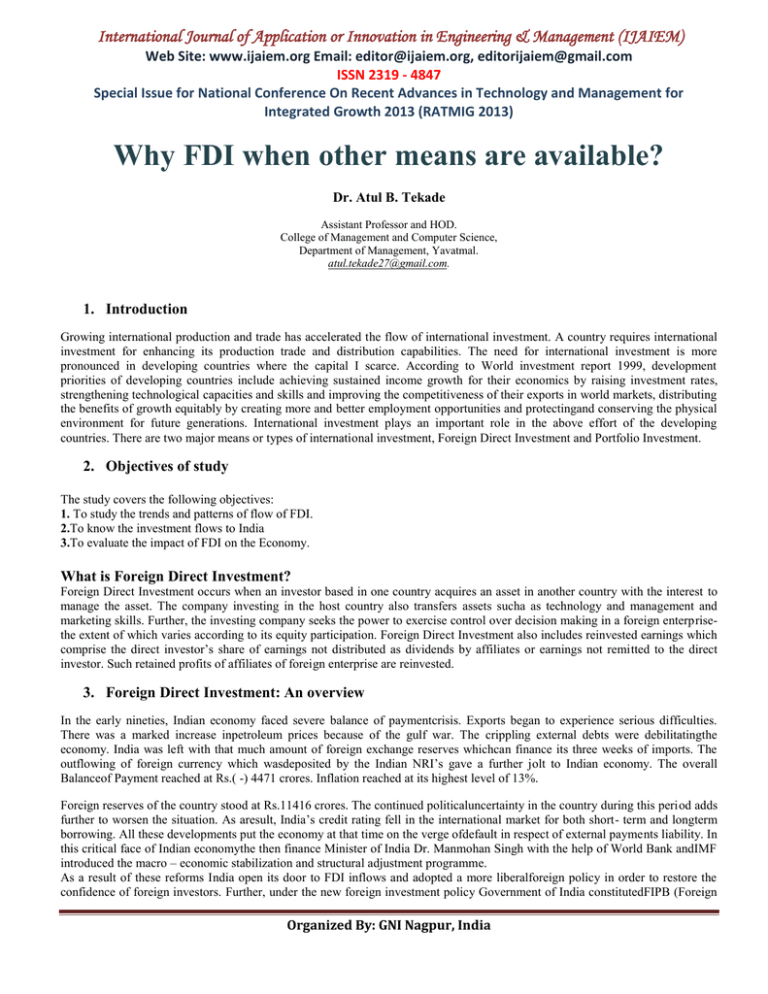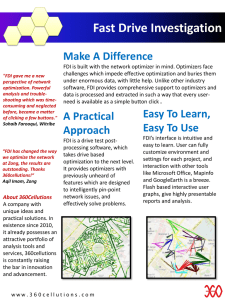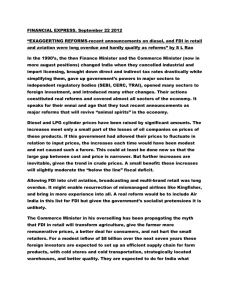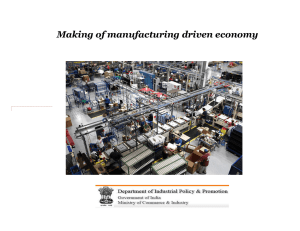International Journal of Application or Innovation in Engineering & Management...
advertisement

International Journal of Application or Innovation in Engineering & Management (IJAIEM) Web Site: www.ijaiem.org Email: editor@ijaiem.org, editorijaiem@gmail.com ISSN 2319 - 4847 Special Issue for National Conference On Recent Advances in Technology and Management for Integrated Growth 2013 (RATMIG 2013) Why FDI when other means are available? Dr. Atul B. Tekade Assistant Professor and HOD. College of Management and Computer Science, Department of Management, Yavatmal. atul.tekade27@gmail.com. 1. Introduction Growing international production and trade has accelerated the flow of international investment. A country requires international investment for enhancing its production trade and distribution capabilities. The need for international investment is more pronounced in developing countries where the capital I scarce. According to World investment report 1999, development priorities of developing countries include achieving sustained income growth for their economics by raising investment rates, strengthening technological capacities and skills and improving the competitiveness of their exports in world markets, distributing the benefits of growth equitably by creating more and better employment opportunities and protectingand conserving the physical environment for future generations. International investment plays an important role in the above effort of the developing countries. There are two major means or types of international investment, Foreign Direct Investment and Portfolio Investment. 2. Objectives of study The study covers the following objectives: 1. To study the trends and patterns of flow of FDI. 2.To know the investment flows to India 3.To evaluate the impact of FDI on the Economy. What is Foreign Direct Investment? Foreign Direct Investment occurs when an investor based in one country acquires an asset in another country with the interest to manage the asset. The company investing in the host country also transfers assets sucha as technology and management and marketing skills. Further, the investing company seeks the power to exercise control over decision making in a foreign enterprisethe extent of which varies according to its equity participation. Foreign Direct Investment also includes reinvested earnings which comprise the direct investor’s share of earnings not distributed as dividends by affiliates or earnings not remitted to the direct investor. Such retained profits of affiliates of foreign enterprise are reinvested. 3. Foreign Direct Investment: An overview In the early nineties, Indian economy faced severe balance of paymentcrisis. Exports began to experience serious difficulties. There was a marked increase inpetroleum prices because of the gulf war. The crippling external debts were debilitatingthe economy. India was left with that much amount of foreign exchange reserves whichcan finance its three weeks of imports. The outflowing of foreign currency which wasdeposited by the Indian NRI’s gave a further jolt to Indian economy. The overall Balanceof Payment reached at Rs.( -) 4471 crores. Inflation reached at its highest level of 13%. Foreign reserves of the country stood at Rs.11416 crores. The continued politicaluncertainty in the country during this period adds further to worsen the situation. As aresult, India’s credit rating fell in the international market for both short- term and longterm borrowing. All these developments put the economy at that time on the verge ofdefault in respect of external payments liability. In this critical face of Indian economythe then finance Minister of India Dr. Manmohan Singh with the help of World Bank andIMF introduced the macro – economic stabilization and structural adjustment programme. As a result of these reforms India open its door to FDI inflows and adopted a more liberalforeign policy in order to restore the confidence of foreign investors. Further, under the new foreign investment policy Government of India constitutedFIPB (Foreign Organized By: GNI Nagpur, India International Journal of Application or Innovation in Engineering & Management (IJAIEM) Web Site: www.ijaiem.org Email: editor@ijaiem.org, editorijaiem@gmail.com ISSN 2319 - 4847 Special Issue for National Conference On Recent Advances in Technology and Management for Integrated Growth 2013 (RATMIG 2013) Investment Promotion Board) whose main function was to invite andfacilitate foreign investment through single window system from the Prime Minister’sOffice. The foreign equity cap was raised to 51 percent for the existing companies. Government had allowed the use of foreign brand names for domestically producedproducts which was restricted earlier. India also became the member of MIGA(Multilateral Investment Guarantee Agency) for protection of foreign investments.Government lifted restrictions on the operations of MNCs by revising the FERA Act1973. New sectors such as mining, banking, telecommunications, highway constructionand management were open to foreign investors as well as to private sector. FDI INFLOWS IN INDIA (from 1948-2010) Table-1.1 Amount of FDI Mid 1948 March 1964 March 1974 March 1980 March 1990 March 2000 March 2010 In Crores 256 565.5 916 933.2 2705 18486 1,23,378 Source: Kumar39 1995, various issues of SIA Publication There is a considerable decrease in the tariff rates on various importable goods.Table –1.1 shows FDI inflows in India from 1948 – 2010.FDI inflows during 1991-92 toMarch 2010 in India increased manifold as compared to during mid 1948 to march 1990. The measures introduced by the government to liberalize provisions relatingto FDI in 1991 lure investors from every corner of the world. There were just few (U.K, USA, Japan, Germany, etc.) major countries investing in India during the period mid1948 to march 1990 and this number has increased to fifteen in 1991. India emerged as astrong economic player on the global front after its first generation of economic reforms. As a result of this, the list of investing countries to India reached to maximum number of120 in 2008. Although, India is receiving FDI inflows from a number of sources but largepercentage of FDI inflows is vested with few major countries. Mauritius, USA, UK,Japan, Singapore, Netherlands constitute 66 percent of the entire FDI inflows to India.FDI inflows are welcomed in 63 sectors in 2008 as compared to 16 sectors in 1991. Chart – 1 FDI Flow in India The FDI inflows in India during mid 1948 were Rs, 256 crores. It is almost double inMarch 1964 and increases further to Rs. 916 crores. India received a cumulative FDIinflow of Rs. 5,384.7 crores during mid 1948 to march 1990 as compared to Rs.1,41,864crores during August 1991 to march 2010 (Table-1.1). It is that there has been a steady flow of FDI in India after its independence. But there is asharp rise in FDI inflows from 1998 onwards. U.K. the prominent investor during the preand post independent era stands nowhere today as it holds a share of 6.1 percent of thetotal FDI inflows to India. Organized By: GNI Nagpur, India International Journal of Application or Innovation in Engineering & Management (IJAIEM) Web Site: www.ijaiem.org Email: editor@ijaiem.org, editorijaiem@gmail.com ISSN 2319 - 4847 Special Issue for National Conference On Recent Advances in Technology and Management for Integrated Growth 2013 (RATMIG 2013) FDI INFLOWS IN INDIA IN POST REFORM ERA India’s economic reforms way back in 1991 has generated strong interest inforeign investors and turning India into one of the favorite destinations for global FDIflows. According to A.T. Kearney1, India ranks second in the World in terms ofattractiveness for FDI. A.T. Kearney’s 2007 Global Services Locations Index ranks Indiaas the most preferred destination in terms of financial attractiveness, people and skillsavailability and business environment. Similarly, UNCTAD’s76 World InvestmentReport, 2005 considers India the 2nd most attractive destination among the TNCS. Thepositive perceptions among investors as a result of strong economic fundamentals drivenby 18 years of reforms have helped FDI inflows grow significantly in India. The FDIinflows grow at about 20 times since the opening up of the economy to foreigninvestment. India received maximum amount of FDI from developing economies (Chart– 1.2). Net FDI flow in India was valued at US$ 33029.32 million in 2008. It is foundthat there is a huge gap in FDI approved and FDI realized (Chart- 1.3). It is observed thatthe realization of approved FDI into actual disbursements has been quite slow. Thereason of this slow realization may be the nature and type of investment projectsinvolved. Beside this increased FDI has stimulated both exports and imports, contributingto rising levels of international trade. India’s merchandise trade turnover increased from US$ 95 bn in FY02 to US$391 bn in FY08 (CAGR of 27.8%). Chart-1.2 India’s exports increased from US$ 44 bn in FY02 to US$ 163 bn in FY08 (CAGR of24.5%). India’s imports increased from US$ 51 bn in FY02 to US$ 251 bn in FY08(CAGR of 30.3%). India ranked at 26th in world merchandise exports in 2007 with ashare of 1.04 percent. Further, the explosive growth of FDI gives opportunities to Indian industry for technological up gradation, gaining access to global managerial skills and practices,optimizing utilization of human and natural resources and competing internationally Organized By: GNI Nagpur, India International Journal of Application or Innovation in Engineering & Management (IJAIEM) Web Site: www.ijaiem.org Email: editor@ijaiem.org, editorijaiem@gmail.com ISSN 2319 - 4847 Special Issue for National Conference On Recent Advances in Technology and Management for Integrated Growth 2013 (RATMIG 2013) withhigher efficiency. Most importantly FDI is central for India’s integration into globalproduction chains which involves production by MNCs spread across locations all overthe world. (Economic Survey 2003-04). 4. The Other Means/ways of Investment 1) Exporting Exporting is the process of sending products that are produced in one country to another country for sell by local businesses. While this may seem like a relatively easy process, it can become very problematic when products are being exported to countries that may not be friendly with the country of origin for the products. For example, many countries are known to place large import tariffs on products from foreign nations. This makes it very difficult for foreign producers to be able to compete in foreign countries because their products have higher retail prices as compared to the same products that are produced in the country in question. Even worse, it is not uncommon for countries to completely prevent the import of certain types of products, even if the import of such products was allowed in the past. If this occurs, a company that once derived a great deal of revenue from exporting a product to a specific country can quickly find its primary market has been closed. Foreign direct investment is essentially a way to overcome any restrictions that are placed on products that are not produced in the country in question. The products are produced in that country, and the country in which the products are being sold are benefiting because local workers are making the products. Any negative issues that may arise because of the idea of foreign products flooding a particular country's market are able to be overcome. The end result for the company making the investment is that they are not only able to control the manufacturing or distribution process, but they are also able to have a hedge against any political or social changes that might occur in a country resulting in the inability for its products to be exported to the country in question. 2) Licensing Licensing is the process by which a company signs a contract with another company to allow it to have access to its intellectual property. An example of this might be a company in the United States that has a patent on a specific type of computer technology. The license agreement might allow the foreign country to use the patented technology to produce a similar product, or even act duplicate product. Another example of the use of a license agreement might be a company allowing its tooling process in a manufacturing operation to be used to produce similar types of products in a foreign country. The key to understanding licensing is that an agreement is created that allows one party's patents or other intellectual property to be used for a specific amount of money in return (Froot 1993, 88). In both of the situations that have been described, the real issue that is present is that the company licensing its product or service is giving control over its product or service to another company. While the licensing agreement may expressly state specific types of controls that will be present, and even specific processes that must be used in the manufacturing or distribution process, the licensor in the agreement is still giving control to the licensee. There is no guarantee that the licensee will fully comply with the license agreement. Even more, there is no agreement that the licensee will have the skills and knowledge to handle problems that may arise in order to preserve the highest reputation of the product, as well as for the licensor's reputation within the business community. 3) Franchising Franchising is very similar to the process of licensing. However, the difference lies in the fact that franchising is the process of gaining the right to use a company's trademark or brand name. Rather than an agreement being established for intellectual property, such as computer technology, an agreement is established for the use of a name, such as being able to use the McDonald's brand name to open a fast-food restaurant in a foreign country. For the ability to use the trademark or the brand name, a fee is paid by the franchisee to the franchiser. As with licensing, the franchising option might appear to have many benefits for the company allowing fort the franchising of its name or other trademarks. The franchising pays a fee for the use of the rights. In addition, most or all of the costs of opening the business using the trademark falls to the franchisee. The franchiser shifts all of the financial burden to the franchisee while Organized By: GNI Nagpur, India International Journal of Application or Innovation in Engineering & Management (IJAIEM) Web Site: www.ijaiem.org Email: editor@ijaiem.org, editorijaiem@gmail.com ISSN 2319 - 4847 Special Issue for National Conference On Recent Advances in Technology and Management for Integrated Growth 2013 (RATMIG 2013) collecting franchise fees. In most cases, the franchisee fees are established at the outset of the agreement. What this means is that he franchiser collects the fees regardless of whether the franchisee makes any money at all in the agreement. The downside in this type of agreement, however, is that the franchiser loses a great deal of control over the franchise operations. While most franchise agreements include specific details about the way in which the trademark or brand name can be used, there is no guarantee that the franchisee will conduct its operations to the same standards that the franchiser has established for its own operations. Again, an example of this can be a fast-food restaurant. A McDonald's restaurant in one location may have the highest standards for customer service and food quality. However, a McDonald's restaurant in another location that is operated by a different franchisee may place very little emphasis on customer service or food quality. The end result is that the company runs the risk of losing customers and having its reputation ruined because of the way in which franchisees use, and even abuse, their trademarks. These potential problems are why many companies favor foreign direct investment instead of franchising. If the company controls the assets related to production and operation, then it can control the standards for customer service and product quality. It does not have to worry about trying to monitor the operations of individual franchisees only to find that they are meeting the requirements of the franchise agreement, even if those standards are at the minimum level of the agreement. Instead, direct investment, along with direct ownership, provides the level of control that is possible in any situation where assets are owned and controlled in the business world. While this may involve greater costs at the outset, it can also prevent greater problems related to disgruntled customers or a tarnished brand name or trademark in the future. 5. Conclusions In the end, 1) Foreign direct investment allows a company to enter a foreign market with the ability to overcome the problems associated with licensing and franchising. Even more, the problems that are associated with import tariffs and with the perceptions that a foreign company is attempting to take over a market to the detriment of local companies can be overcome. 2) The assets associated with the local operations may be owned by a foreign company, but the operations are still local. Residents of the country are employed and the products that are manufactured are local products. 3) Finally, the company making the foreign direct investment can control the local operations and ensure that those operations meet the standards it has set for how it interacts with customers, as well as the quality of the products that customers receive, regardless of where they may be in the world when they by one of those products. References [1] Bradford, C. I. & Branson, W. H., 1988. Trade and Structural Change in Pacific Asia.Chicago: University of Chicago Press. [2] De Jong, H. W., The Structure of European Industry. Norwell, MA: Kluwer Academic Publishers, 1993. [3] Feenstra, R. C., Trade Policies for International Competitiveness. Chicago: University of Chicago Press, 1989. [4] Froot, K., Foreign Direct Investment. Chicago: University of Chicago Press, 1993. [5] Hill, C. W. L., Global Business Today. New York: McGraw-Hill, 2007. [6] Johnson, D. & Turner, C., International Business. London: Routledge, 2003. [7] Lashley, C. & Morrison, Franchising Hospitality Services. London:Butterworth-Heinemann, 2000. [8] Moosa, I. A., Foreign Direct Investment. New York: Palgrave, 2002 Organized By: GNI Nagpur, India International Journal of Application or Innovation in Engineering & Management (IJAIEM) Web Site: www.ijaiem.org Email: editor@ijaiem.org, editorijaiem@gmail.com ISSN 2319 - 4847 Special Issue for National Conference On Recent Advances in Technology and Management for Integrated Growth 2013 (RATMIG 2013) Author 1. Dr. Atul B. Tekade(M.Sc., MBA, Ph.D.), received his degrees of M.Sc. in Organic Chemistry and M.B.A in Marketing & HRM from SantGadge Baba Amravati University, Amravati and RashtraSantTukdojiMaharaj, Nagpur University Nagpur respectively. Also, he has been honored by Doctorate degree from RashtraSantTukdojiMaharaj, Nagpur University Nagpur in the subject Business Management (Commerce). 2. Since 1st July 2009, he is working as an Assistant professor and HOD in MBA department at College of Management and Computer Science, Yavatmal, to till date. He is also working as a lecturer (Counsellor) for YCMOU (Centre-AmolakchandMahavidyalaya, Yavatmal), since 1st June 2008 to till date. Organized By: GNI Nagpur, India






